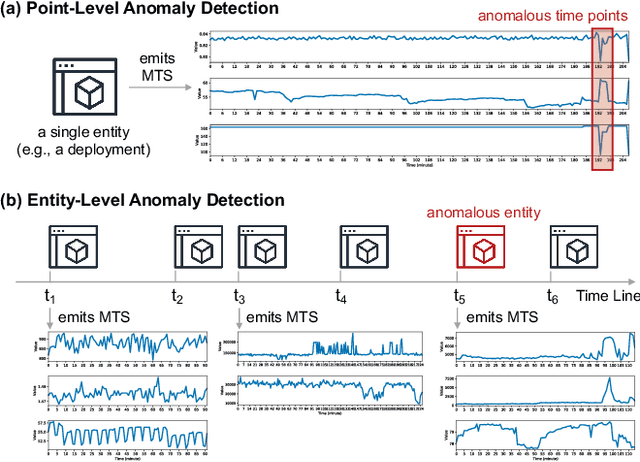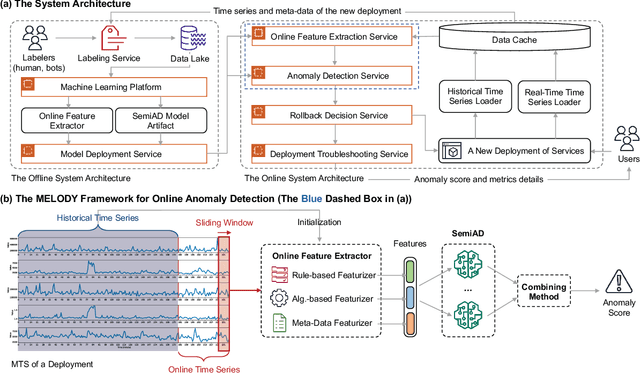Gauthier Guinet
Voxtral
Jul 17, 2025Abstract:We present Voxtral Mini and Voxtral Small, two multimodal audio chat models. Voxtral is trained to comprehend both spoken audio and text documents, achieving state-of-the-art performance across a diverse range of audio benchmarks, while preserving strong text capabilities. Voxtral Small outperforms a number of closed-source models, while being small enough to run locally. A 32K context window enables the model to handle audio files up to 40 minutes in duration and long multi-turn conversations. We also contribute three benchmarks for evaluating speech understanding models on knowledge and trivia. Both Voxtral models are released under Apache 2.0 license.
Magistral
Jun 12, 2025Abstract:We introduce Magistral, Mistral's first reasoning model and our own scalable reinforcement learning (RL) pipeline. Instead of relying on existing implementations and RL traces distilled from prior models, we follow a ground up approach, relying solely on our own models and infrastructure. Notably, we demonstrate a stack that enabled us to explore the limits of pure RL training of LLMs, present a simple method to force the reasoning language of the model, and show that RL on text data alone maintains most of the initial checkpoint's capabilities. We find that RL on text maintains or improves multimodal understanding, instruction following and function calling. We present Magistral Medium, trained for reasoning on top of Mistral Medium 3 with RL alone, and we open-source Magistral Small (Apache 2.0) which further includes cold-start data from Magistral Medium.
Large Language Model Critics for Execution-Free Evaluation of Code Changes
Jan 28, 2025



Abstract:Large language models (LLMs) offer a promising way forward for automating software engineering tasks, such as bug fixes, feature additions, etc., via multi-step LLM-based agentic workflows. However, existing metrics for evaluating such workflows, mainly build status and occasionally log analysis, are too sparse and limited in providing the information needed to assess the quality of changes made. In this work, we designed LLM-based critics to derive well-structured and rigorous intermediate/step-level, execution-free evaluation proxies for repo-level code changes. Importantly, we assume access to the gold test patch for the problem (i.e., reference-aware) to assess both semantics and executability of generated patches. With the gold test patch as a reference, we predict executability of all editing locations with an F1 score of 91.6%, aggregating which, we can predict the build status in 84.8% of the instances in SWE-bench. In particular, such an execution-focused LLM critic outperforms other reference-free and reference-aware LLM critics by 38.9% to 72.5%. Moreover, we demonstrate the usefulness of such a reference-aware framework in comparing patches generated by different agentic workflows. Finally, we open-source the library developed for this project, which allows further usage for either other agentic workflows or other benchmarks. The source code is available at https://github.com/amazon-science/code-agent-eval.
Automated Evaluation of Retrieval-Augmented Language Models with Task-Specific Exam Generation
May 22, 2024



Abstract:We propose a new method to measure the task-specific accuracy of Retrieval-Augmented Large Language Models (RAG). Evaluation is performed by scoring the RAG on an automatically-generated synthetic exam composed of multiple choice questions based on the corpus of documents associated with the task. Our method is an automated, cost-efficient, interpretable, and robust strategy to select the optimal components for a RAG system. We leverage Item Response Theory (IRT) to estimate the quality of an exam and its informativeness on task-specific accuracy. IRT also provides a natural way to iteratively improve the exam by eliminating the exam questions that are not sufficiently informative about a model's ability. We demonstrate our approach on four new open-ended Question-Answering tasks based on Arxiv abstracts, StackExchange questions, AWS DevOps troubleshooting guides, and SEC filings. In addition, our experiments reveal more general insights into factors impacting RAG performance like size, retrieval mechanism, prompting and fine-tuning. Most notably, our findings show that choosing the right retrieval algorithms often leads to bigger performance gains than simply using a larger language model.
Semi-Supervised Learning for Bilingual Lexicon Induction
Feb 10, 2024



Abstract:We consider the problem of aligning two sets of continuous word representations, corresponding to languages, to a common space in order to infer a bilingual lexicon. It was recently shown that it is possible to infer such lexicon, without using any parallel data, by aligning word embeddings trained on monolingual data. Such line of work is called unsupervised bilingual induction. By wondering whether it was possible to gain experience in the progressive learning of several languages, we asked ourselves to what extent we could integrate the knowledge of a given set of languages when learning a new one, without having parallel data for the latter. In other words, while keeping the core problem of unsupervised learning in the latest step, we allowed the access to other corpora of idioms, hence the name semi-supervised. This led us to propose a novel formulation, considering the lexicon induction as a ranking problem for which we used recent tools of this machine learning field. Our experiments on standard benchmarks, inferring dictionary from English to more than 20 languages, show that our approach consistently outperforms existing state of the art benchmark. In addition, we deduce from this new scenario several relevant conclusions allowing a better understanding of the alignment phenomenon.
MELODY: Robust Semi-Supervised Hybrid Model for Entity-Level Online Anomaly Detection with Multivariate Time Series
Jan 18, 2024



Abstract:In large IT systems, software deployment is a crucial process in online services as their code is regularly updated. However, a faulty code change may degrade the target service's performance and cause cascading outages in downstream services. Thus, software deployments should be comprehensively monitored, and their anomalies should be detected timely. In this paper, we study the problem of anomaly detection for deployments. We begin by identifying the challenges unique to this anomaly detection problem, which is at entity-level (e.g., deployments), relative to the more typical problem of anomaly detection in multivariate time series (MTS). The unique challenges include the heterogeneity of deployments, the low latency tolerance, the ambiguous anomaly definition, and the limited supervision. To address them, we propose a novel framework, semi-supervised hybrid Model for Entity-Level Online Detection of anomalY (MELODY). MELODY first transforms the MTS of different entities to the same feature space by an online feature extractor, then uses a newly proposed semi-supervised deep one-class model for detecting anomalous entities. We evaluated MELODY on real data of cloud services with 1.2M+ time series. The relative F1 score improvement of MELODY over the state-of-the-art methods ranges from 7.6% to 56.5%. The user evaluation suggests MELODY is suitable for monitoring deployments in large online systems.
Effective Dimension in Bandit Problems under Censorship
Feb 14, 2023



Abstract:In this paper, we study both multi-armed and contextual bandit problems in censored environments. Our goal is to estimate the performance loss due to censorship in the context of classical algorithms designed for uncensored environments. Our main contributions include the introduction of a broad class of censorship models and their analysis in terms of the effective dimension of the problem -- a natural measure of its underlying statistical complexity and main driver of the regret bound. In particular, the effective dimension allows us to maintain the structure of the original problem at first order, while embedding it in a bigger space, and thus naturally leads to results analogous to uncensored settings. Our analysis involves a continuous generalization of the Elliptical Potential Inequality, which we believe is of independent interest. We also discover an interesting property of decision-making under censorship: a transient phase during which initial misspecification of censorship is self-corrected at an extra cost, followed by a stationary phase that reflects the inherent slowdown of learning governed by the effective dimension. Our results are useful for applications of sequential decision-making models where the feedback received depends on strategic uncertainty (e.g., agents' willingness to follow a recommendation) and/or random uncertainty (e.g., loss or delay in arrival of information).
* 45 pages, 5 figures, NeurIPS 2022
Pareto-efficient Acquisition Functions for Cost-Aware Bayesian Optimization
Nov 24, 2020



Abstract:Bayesian optimization (BO) is a popular method to optimize expensive black-box functions. It efficiently tunes machine learning algorithms under the implicit assumption that hyperparameter evaluations cost approximately the same. In reality, the cost of evaluating different hyperparameters, be it in terms of time, dollars or energy, can span several orders of magnitude of difference. While a number of heuristics have been proposed to make BO cost-aware, none of these have been proven to work robustly. In this work, we reformulate cost-aware BO in terms of Pareto efficiency and introduce the cost Pareto Front, a mathematical object allowing us to highlight the shortcomings of commonly used acquisition functions. Based on this, we propose a novel Pareto-efficient adaptation of the expected improvement. On 144 real-world black-box function optimization problems we show that our Pareto-efficient acquisition functions significantly outperform previous solutions, bringing up to 50% speed-ups while providing finer control over the cost-accuracy trade-off. We also revisit the common choice of Gaussian process cost models, showing that simple, low-variance cost models predict training times effectively.
 Add to Chrome
Add to Chrome Add to Firefox
Add to Firefox Add to Edge
Add to Edge